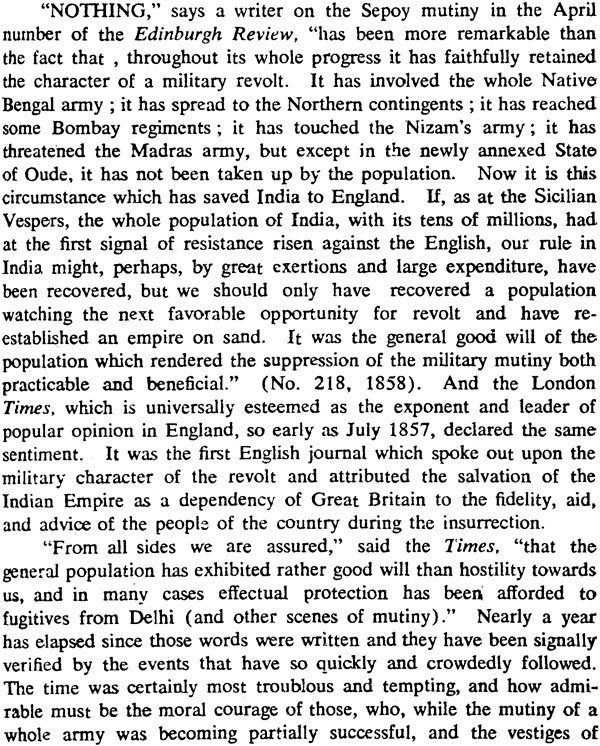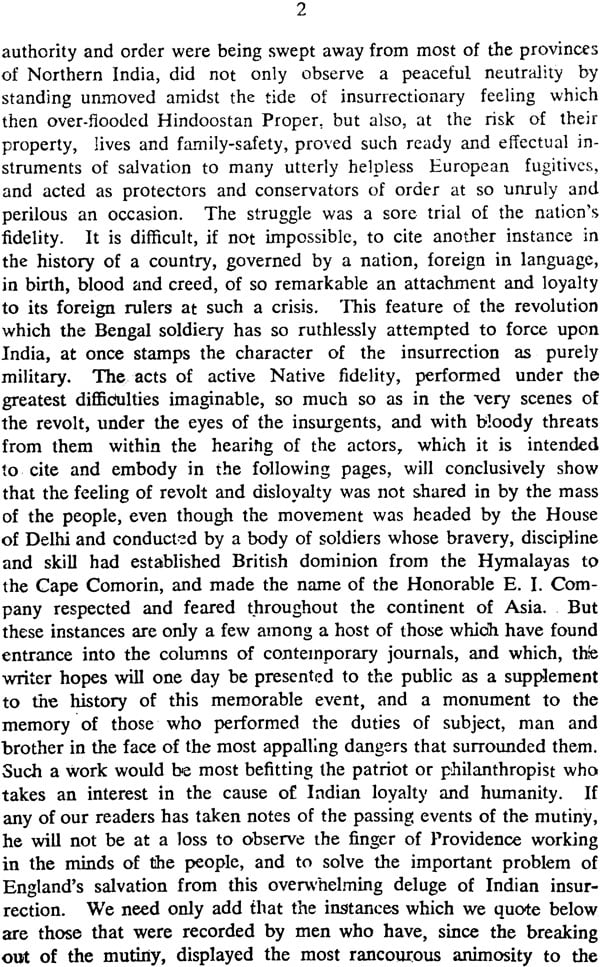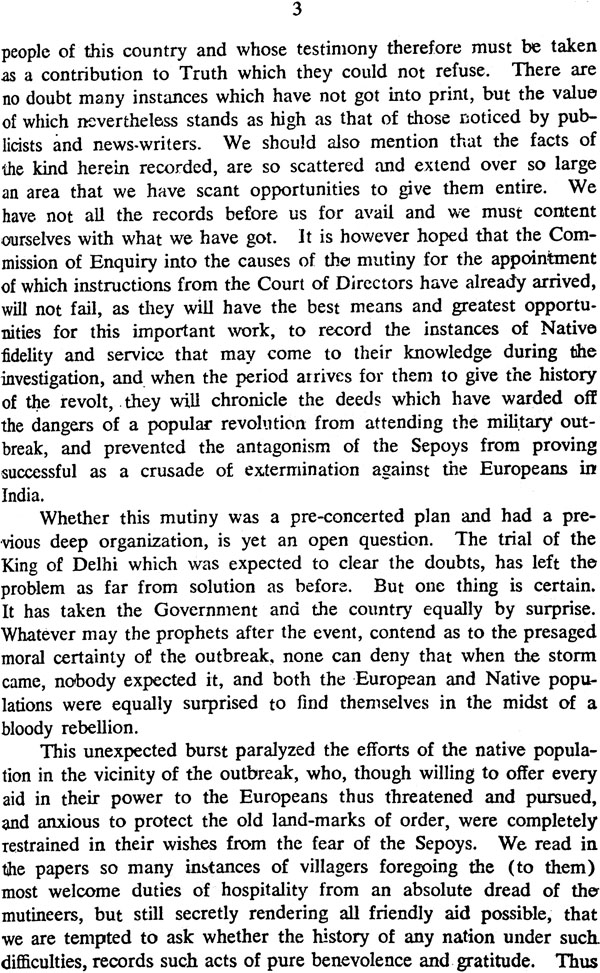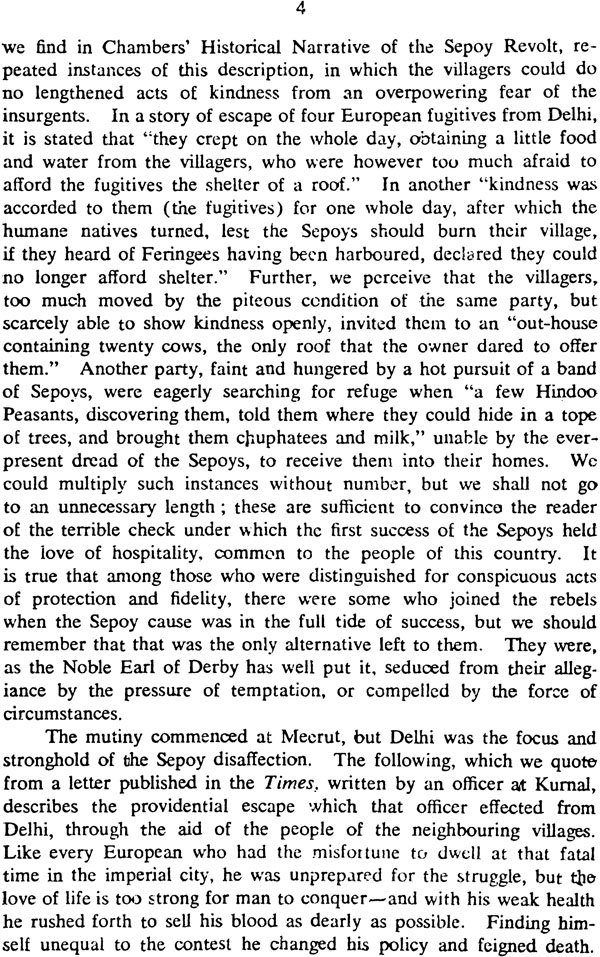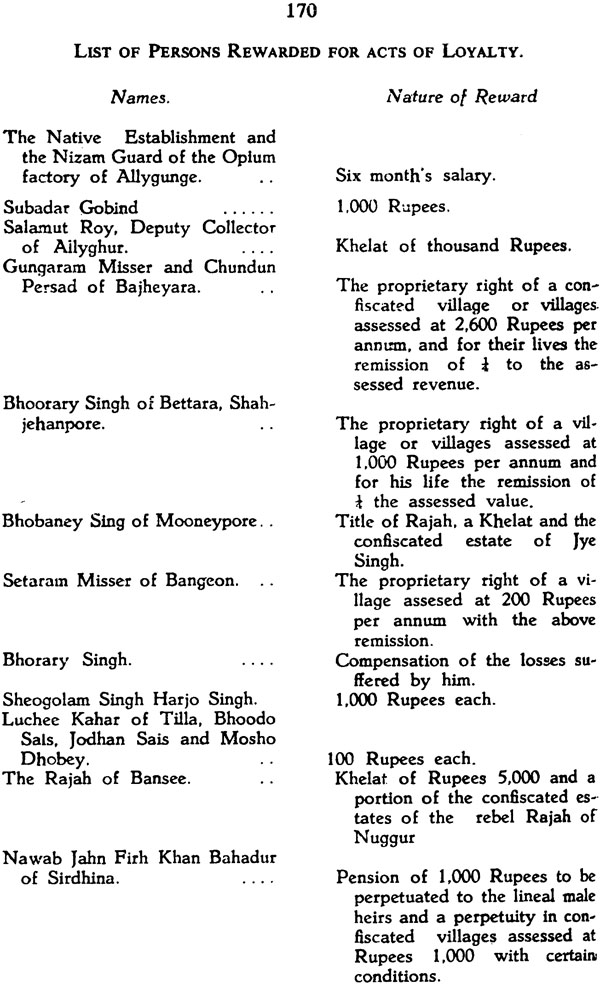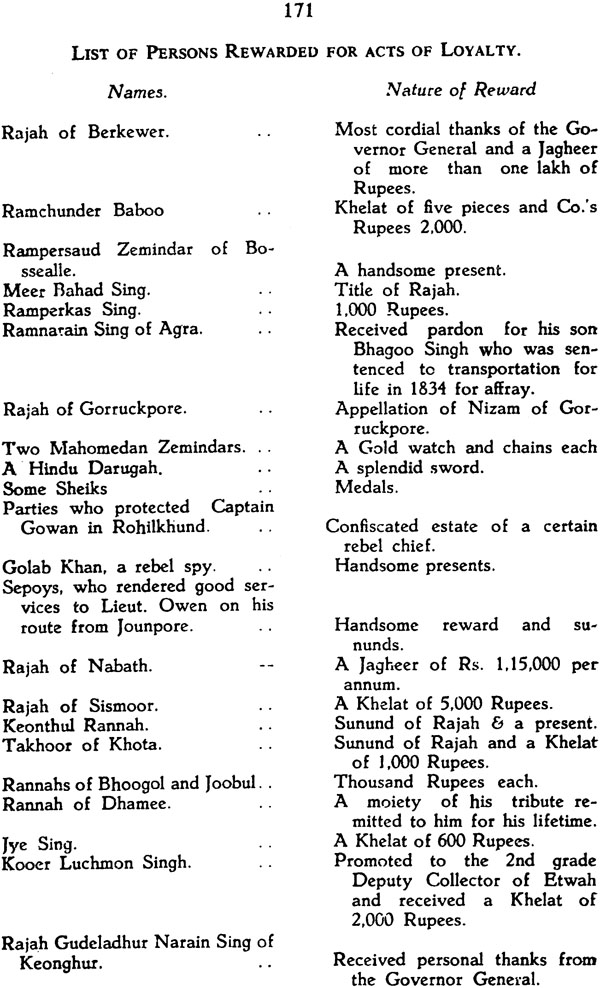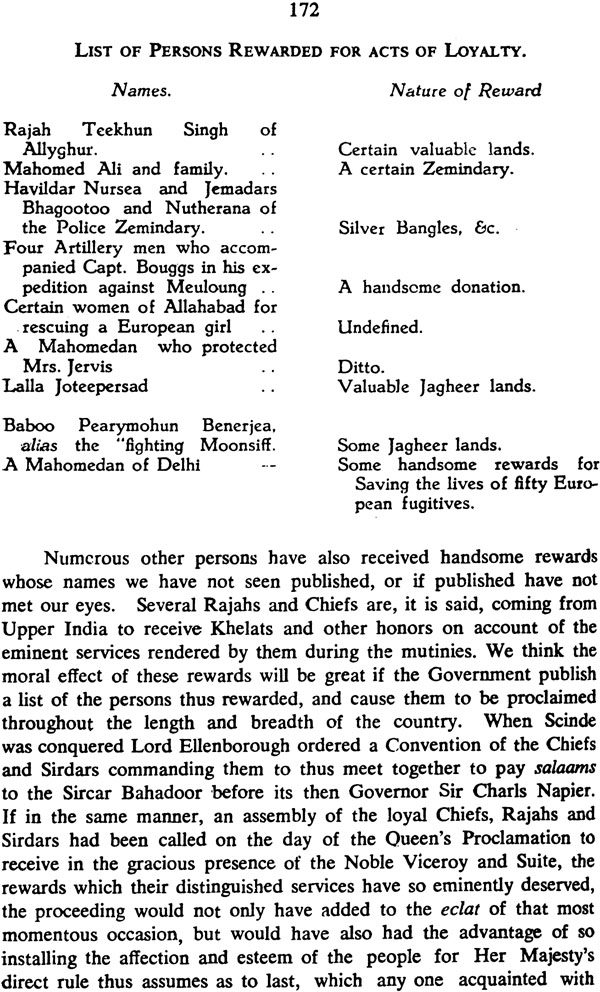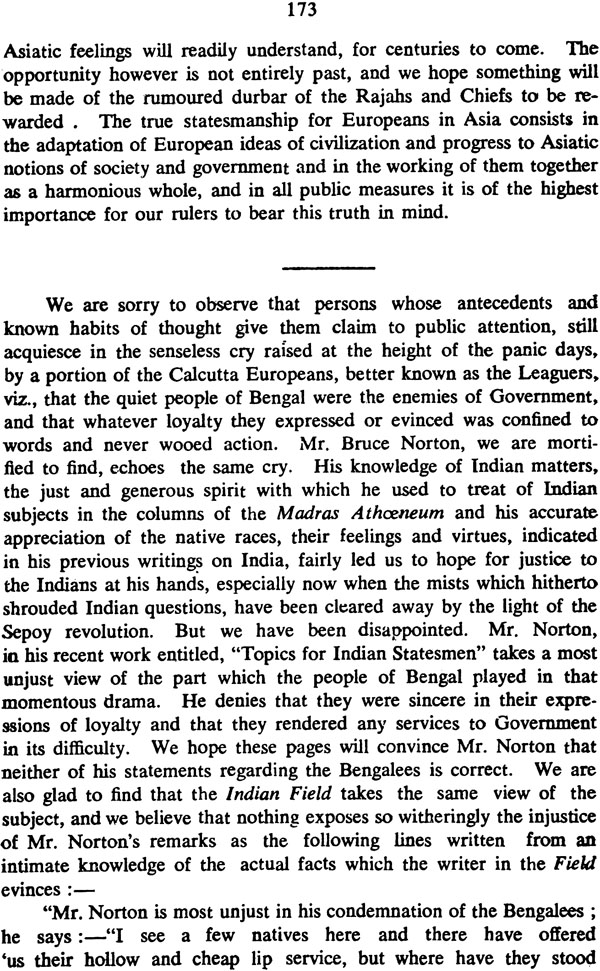
The Mutinies and The People or Statements of Native Fidelity (Exhibited During The Outbreak of 1857-58)
Book Specification
| Item Code: | NAJ559 |
| Publisher: | THE ASIATIC SOCIETY |
| Language: | English |
| Edition: | 2007 |
| Pages: | 192 |
| Cover: | Hardcover |
| Other Details | 8.5 X 5.5 inch |
| Weight | 310 gm |
Book Description
This book is not a serious historical study of the Sepoy Mutiny of 1857. It should better be described as a handy volume of newspaper cuttings, with a sprightly running commentary of the author. The work has an impressive contemporaneity, which may be marred by editorial emendations. It is also an interesting document which clearly reveals the ideology and the milieu of a young Bengali journalist of the mid-nineteenth century.
The author of this work was Sambhu Chandra Mookerjee.
He was born at Baranagar, Calcutta, in 1839. His father was an affluent businessman. He was a student of Oriental Seminary and the Hindu Metropolitan College. He was a pupil of Captain D.L. Richardson, the famous Professor of English Literature, about whom Thomas Babington Macaulay was reported to have said:
"I can forget everything of India, but I can never forget your reading of Shakespeare."!
It is no wonder that Sambhu Chandra, a pupil of Richardson, should have had a predilection for English. But he himself gave another reason for it. In 1883, Meredith Townsend, a British scholar, expostulated with him for his preference for English. Sambhu Chandra told him that he had an abiding love for his mother-tongue; but unfortunately the English rulers paid no heed to native grievances and demands couched in Bengali. Writing out his thoughts in English was no pleasure to him. He would have been a famous man if he wrote them in Bengali.
Even when he was a young College-Student, Sambhu Chandra was a practising journalist. He was a dear friend and colleague of Krishnadas Pal, another up-and-coming young journalist. They were the joint editors of the Calcutta Monthly Magazine, which was very short-lived. He next worked for The Morning Chronicle and The Hindu Intelligencer. Later, he attached himself to the celebrated Hindu Patriot, edited by Harish Chandra Mukherjee, of the Indigo-Rebellion-fame. From 1861 to 1882, Sambhu Chandra edited a lively monthly, Mookerjee's Magazine, which was merged in his weekly, Reis and Rayyet, in 1882. He was a restless man. Sometime he was the headmaster of Calcutta Training School, and afterwards, the Dewan of the Nawab of Murshidabad, the Secretary to the Raja of Kashipur, the Personal Assistant of the Raja of Rampur, and a Minister of the Maharajah of Tripura. He was also a Fellow of the University of Calcutta.
Sambhu Chandra believed in liberalism. He believed, like his compatriots, in liberal methods of agitation. Violence against the white rulers was, to him and to them, an anathema. But though he was a believer in the efficacy of political moderation, he was not a dumb camp-follower of the British.
In 1860, three years after the Great Rebellion, he wrote a pamphlet criticising the British move for the imposition of the income tax upon the Indians. He wrote that an unrepresented people could never be taxed. The pamphlet revealed his acquaintance with, and respect for the American dictum: 'No taxation, without representation'. He even went so far as to describe Canning as an irresponsible, inconsiderate Viceroy brought by Palmerston, through the backdoor, to the helm of affairs in India.
He pleaded with the Government to create more and better opportunities for employment because, he thought, unemployment was making the young people increasingly hostile to the foreign rulers.
In 1875, he formed the India League with celebrities like Sishir Kumar Ghosh, Durga Mohan Das, and Ananda Mohan Basu. The League's object was the ventilation of Indian grievances. He was its President. He fought hard and long for the Ilbert Bill which proposed to extend the jurisdiction of the Indian judges over the Europeans in India (1883). When the Government ultimately withdrew the Bill, he suggested, in 1886, that an Indian should be the Legal Member of the Viceroy's Executive Council.
He was perhaps the solitary Bengali politician of the time to devote time and energy to the promotion of Mu ham mad an interests. His death in 1894 was a great shock to the Bengali Muhammadans. He was offered a title by the provincial government; but he declined the offer, and proved his freedom from the contemporary middle-class hankering for governmental titles and back-patting.
His hobby was homoeopathy. He got the M.D. degree from an American university.
Such was the man.
Sambhu Chandra wrote this book when he was only 18. This is indeed a remarkable fact. The style is mature. The consistency of views and opinions is scarcely affected by unnecessary digressions. The work is doubtless an evidence of young Sambhu Chandra's intellectual brilliance.
A budding journalist, he gathered his materials from journalistic writings, both Anglo-Indian and British. He has not referred to a single vernacular newspaper or journal in his book. The Edinburgh Review, The London Times, The Westminster Review, The Muffussilite, The Quarterly Review,' The Englishman, The Bombay Telegraph and Courier, The Phoenix, The Government Gazette, The Examiner, The Friend of India, The Hurkaru, The Indian Field, The Official Blue Books on The Mutinies, Raikes' Notes on the Revolt in the North West Provinces of India, The Lahore Chronicle, and Chambers' Chronicle of the Indian Revolt,-these are the newspapers, journals, documents and historical works from which Sambhu Chandra has compiled the details of native fidelity during the Sepoy Mutiny. His views are outdated. That a Bengali student of 18 collected data on a subject of current interest from so wide a range of sources is, however, a wondrous thing. It is certainly an indication of his great intellectual capability, and a pointer to his later eminence as a journalist and a political philosopher.
Lord Canning's "Control of the Press Act" banned the publication of political pamphlets in India. Sambhu Chandra, therefore, got his work published at London in 1857. This he did with the help of one Mr. Malcolm Lewin, a former judge of the Sadar Adalat of Madras who had protested 'against injustice done to Hindus in cases involving Christians', and had consequently lost his job.
The London edition of this book was anonymously published in Calcutta in 1859, and reprinted in 1905. Kishori Chand Mitra, another eminent journalist, the editor of the Indian Field, also wrote anonymously in 1858, a pamphlet titled The Mutinies, the Government, and the People. This work was published at Calcutta. But Mookherjee's and Mitra's works are different, and are not to be confused.
Sambhu Chandra was certainly not a lackey of the British. Why did he, then, write this book on native fidelity during the Sepoy Mutiny? Why was he so much eager to show that the Indians were not really disloyal?
The fact was that the Bengali 'Bhadralok' had no sympathy for the rebels. "In Bengal", says Dr. S.N. Sen, "the sepoys rose in many places but no where did they experience any sympathy from the local people. The only evidence to the contrary is furnished by a letter alleged to have emanated from two Dacca notables, Kali Narayan Choudhury and Moghul Agha Ghulam Ali, in which they have claimed to have financed the rebel regiments. This letter the Government treated as a fabrication.
One reason behind the Bengali's abhorrence of the Mutiny was his sense of superiority. It stemmed from his cultural and commercial associations with the British. The permanent settlement eventually gave the Bengali landlords "an enormous increase in rent at the expense of the state and the ryots The amount to be paid by the Zamindars was fixed at three and three-quarter millions sterling, while the rents received by them now exceeded thirteen millions. The state once and for all parted with the power to divert a portion of this unearred increment, and the rest of India had to be taxed more heavily that Bengal landlords may enjoy a position of special emolument.
The Bengali Baboo and the Bengali landlord were the earliest beneficiaries of the British conquest of India. Neither the Baboo, proud of his material and intellectual commerce with the British, nor the landlord, basking in the warmth of unearned income eternally accruing from the Permanent Settlement, could possibly feel any sympathy for the lowly rebels, who fought their white masters from 'western Bihar to the eastern confines of the Punjab'." Sambhu Chandra has noted that the chief supporters of the British rule in India were the native landlords. Their 'universal good conduct' was a distinctive feature of the Mutiny. "Many well informed Indian thinkers have come to the opinion that the best safeguard ... against calamities of the kind lies in the extension of the farseeing and most statesmanlike Land Settlement of Lord Cornwallis."? Not that 'the Baboo' was insensible to the growing misery of the people. "There is not a single native of India", wrote the editor of the Hindu Patriot, Harish Chandra Mookerjee, on 21 May, 1857, "who does not feel the full weight of the grievances imposed upon him by the very existence of the British rule in India- grievances inseparable from subjection to a foreign rule." But the special position of the Bengali 'Bhadralok' compelled him to make convincing protestations of his own fidelity. Kishori Chand Mitra, in his pamphlet on the Mutiny to which we have referred; wrote:
"The insurrection is essentially a military insurrection. It is the revolt of a lac of Sepoys It has nothing of the popular element in it. The proportion of those who have joined the rebels sinks into nothingness when compared with those whose sympathies are enlisted with the Government. While the former may be counted by thousands the latter may be counted by millions.
Despite his expression of fidelity, Kishori Chand Mitra, incidentally, was dismissed from his highly-salaried post of Deputy Magistrate, Calcutta, thanks to the machinations of white opponents, on 28 October, 1858.
Harish Chandra Mookerjee, the editor of the Hindu Patriot, noted the general restiveness; but he, too, was sure of the fidelity of the natives. 'Baboos Pran Kissen Roy Chowdry and Juggut Chunder Roy Chowdry, Zemindars of Paneehati' performed a typically loyal act. They 'explained to the people of their zemindarees (about 50,000 in number) the Govt. Proclamation, dated 16th May, 1857, assuring them that Govt. never interfered or intended to interfere with their religious beliefs and customs, and exhorted them to loyalty by setting forth the advantages the country has derived from the British rule'.
